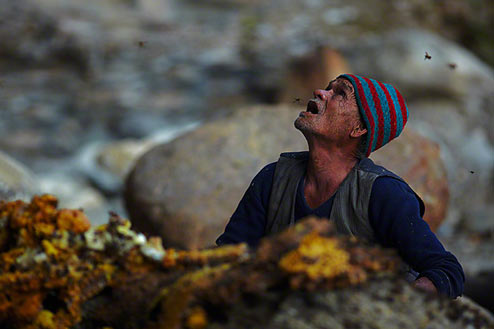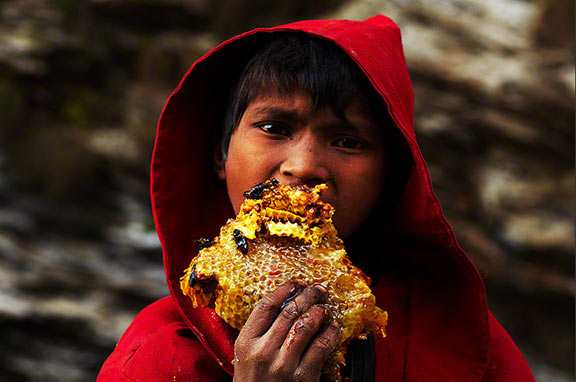
The Ancient Art of Honey Collecting on the Himalayan Cliffs of Nepal
The Gurung tribespeople of Nepal have been collecting honey from Himalayan cliffs for centuries, risking their lives in an ancient tradition that has been passed down over many generations. But now the three-day honey hunt, which occurs twice every year, is under threat from rapidly declining bee populations, commercialization of medicinal honey and tourism.
The Honey Collecting Gurung People of Nepal
The Gurung people, also called Tamu, are an indigenous tribe living within Nepal’s mountain valleys. Gurung history is clouded with uncertainty because of their lack of written accounts from the past. However, it is believed that the Gurung ethnic group migrated from Tibet in the 6th century AD to the central region of Nepal.
- Getting Buzzed: The History of Hallucinogenic Mad Honey
- The Araña Caves of Valencia: Entering a Bygone Era Through Rock Art
The Gurung tribesmen of Nepal are master honey hunters, risking their lives collecting honeycomb in the foothills of the Himalayas, using nothing more than handmade rope ladders and long sticks known as tangos. Most of the honey bees' nests are located on steep inaccessible cliffs, out of reach of predators and increasing their exposure to sunlight.

A honey hunter hangs from a hand-made rope ladder. (Photo credit: Eric Valli)
Photographing Honey Collecting with the Gurung
In December 2013, photographer Andrew Newey spent two weeks living with the Gurung in a remote hilltop village in central Nepal’s Kaski district, joining the three-day autumn honey hunt, and documenting the risks and skills involved in this dying tradition.
“For hundreds of years, the skills required to practice this ancient and sacred tradition have been passed down through the generations, but now both the number of bees and traditional honey hunters are in rapid decline as a result of increased commercial interests and climate change,” wrote Newey.
Before the honey collection begins, the honey hunters, known as kuiche, are required to perform a ceremony to placate the cliff gods. This involves sacrificing a sheep, offering flowers, fruits and rice, and praying to the cliff gods to ensure the safety of the collectors. Having the protection of the gods certainly comes in handy as the honey hunters scale the cliffs, harness free, and rely only on old hand-made rope ladders that have been handed down by their ancestors.

A man looks up with concern as a honey hunter hangs from a rope ladder. (Andrew Newey)
Honey Hunting Nepalese Honey Bees
The honey hunters use smoke to drive out thousands of angry Apis Laboriosa, the largest honey bee in the world, from their nests. Long sticks called tangos, with a sickle at one end, are used to cut the exposed honeycomb away from the cliff face.
Using another stick to guide the basket hanging beside him, the honey hunter catches the honeycomb as it falls before the basket is then lowered to the ground. Up to a dozen men are drafted to support the hunter in his efforts. After a three-hour trek back up to the village carrying approximately 20 kg (44 oz) of honey, the honey is divided up among the villagers and one of the first uses is for a cup of honey tea.

Enjoying the fruits of the hunter’s labors after honey collecting. (Andrew Newey)
Under Threat: Traditional Honey Collecting is a Dying Art
Honey collecting in Nepal is threatened by several things: the decreasing number of honey bees due to climate change; the dwindling number of honey hunters, as more and more young people in the tribe are reluctant to learn the craft; the growing medicinal reputation of Himalayan honey, which has resulted in the government opening honey-harvesting rights to contractors instead of indigenous tribespeople so that honey can be exported and sold to people in other nations; and the increasing commercialization and offering of "honey hunt tours" to tourists, which leads to the depletion of resources for traditional honey hunters.
- Honey Liquid Gold Of The Ancient World
- Etruscans Transported Bees by Boat to Reach the Best Flowers!
Honey harvesting is one of the most ancient human activities recorded and is still practiced by indigenous societies in parts of Africa, Asia, Australia and South America. Some of the earliest evidence of gathering honey from wild colonies is from rock painting, dating back 8,000 years and found in the Araña Caves of Valencia, Spain.
Top image: A honey collecting honey hunter in Nepal. Source: Andrew Newey
By Joanna Gillan
















Comments
can you sell himalayan nepalese wild comb honey in the linmk above
Here is amazing video of the process. With some side effects.
http://www.youtube.com/watch?v=Y_b2i_FvYPw